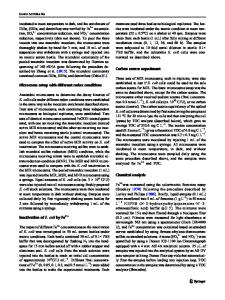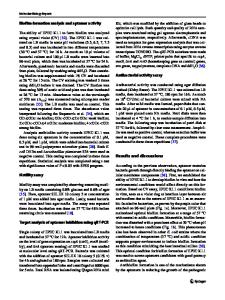Determining Mechanical Properties of Escherichia Coli by Nanoindentation
- PDF / 283,550 Bytes
- 6 Pages / 432 x 648 pts Page_size
- 56 Downloads / 360 Views
Determining Mechanical Properties of Escherichia Coli by Nanoindentation C. A. Wright1,4, C.J. Sullivan2, B. Crawford3, L.D. Britt2, M.A. Mamun1,4, and,A.A. Elmustafa1,4 Department of Mechanical and Aerospace Engineering, Old Dominion University, Norfolk, Virginia 23529, USA 2 Department of Surgery, Eastern Virginia Medical School, Norfolk, VA 23501 3 Nanomechanics, Inc., Oak Ridge, TN 37830 4 Applied Research Center, Jefferson National Accelerator Facility, Newport News, Virginia 23606, USA 1
ABSTRACT Escherichia coli, like other gram-negative bacteria, is protected from the surrounding harsh environment by a cell wall consisting of the peptidoglycan and outer membrane. Whereas the cytoplasmic membrane is the selective barrier, the cell wall provides mechanical strength for the cell. As bacteria navigate various environments, osmotic pressure can change dramatically due to changes in local solute concentration. The peptidoglycan together with the cellular proteins mitigates the osmotic stress that would otherwise cause lysis. The mechanical properties of E. coli cells and its individual layers have been largely indeterminable until the recent development of probe-based measurement tools. Since their invention, scientists have reported significant data measuring elasticity, modulus, and stiffness using atomic force microscopy (AFM). Fundamentally, in order to determine these mechanical properties through probe-based techniques, the contact area and load should be well defined. The load can be precisely calculated through the AFM cantilever spring constant. However, the silicon tip contact area can only be estimated, potentially leading to compounding uncertainties. Therefore, we developed a methodology to determine nanomechanical properties of E. coli using a nanoindenter. INTRODUCTION Atomic force microscopy (AFM) has been used in the past to measure the mechanical properties of E.coli [1-3].Though progress been made to accurately measure the mechanical properties of E. coli with an AFM there are inherent problems in the process. AFM tips are typically made from silicon or silicon nitride. These tips are mass produced and manufactured under strict tolerances but have an under-defined tip shape. Under-defined or erroneous probe geometries can directly affect the accuracy of hardness calculations. Another potential problem when measuring nanomechanical properties lies with the AFM cantilever spring. The AFM cantilever spring constant can be estimated as described [4-6]. However, the indirect loading action causes problems when analyzing biological sampleswhich have time-dependent mechanical responses. Also, when using an AFM, the point of contact of the tip is grossly estimated. This can lead to significant errors in the calculations that are based on the estimate. Even if tip geometry is intimately understood, an unknown contact point will cause errors in both hardness and modulus of elasticity. For the given reasons, nanoindentation, a more precise methodology, has been employed to accurately characterize the prop
Data Loading...










